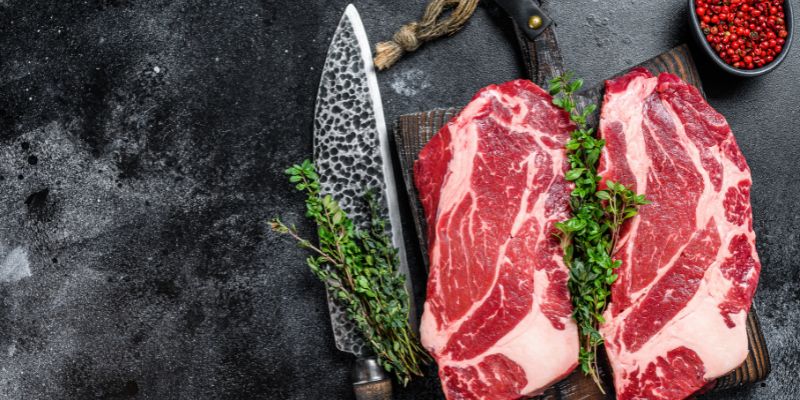Must See the Factors That Affect Meat Cooking Time
Sep 05, 2023 By Cassandra Bailey
Whether you're a seasoned chef or just someone who enjoys cooking at home, understanding the factors that affect meat cooking times is essential for achieving perfectly cooked dishes every time. Cooking meat to the internal temperature ensures both safety and optimal flavor.
In this article, I'll explore the key aspects that influence how long it takes to cook different types of meat. From thickness and cut to the cooking method and starting temperature, these factors are crucial in determining the ideal cooking time for your meats.

The Role of Meat Cut and Texture
Choosing the proper meat cut is where the magic begins. Different cuts come from different parts of the animal, and these areas have varying levels of connective tissue and fat. Cuts with more connective tissue, like chuck or brisket, require longer cooking times to break down the collagen and become tender. On the other hand, cuts with less connective tissue, like tenderloin or sirloin, need shorter cooking times to avoid becoming tough.
Thickness Matters
The thickness of the meat directly impacts how long it needs to cook. Thicker cuts take longer to cook through uniformly. When dealing with thick cuts, such as a hearty ribeye steak, sear the meat on high heat first to develop a flavorful crust, then finish cooking it at a lower temperature to ensure that the interior is properly cooked without overcooking the exterior.
Initial Meat Temperature
Starting with the right meat temperature can make or break your cooking. If you take meat from the refrigerator and cook it, the exterior might overcook when the center reaches the desired temperature. Allowing the meat at room temperature before cooking ensures it cooks more evenly throughout.
The Art of Searing
Searing isn't just about creating that delightful crust on the meat's surface; it's also about enhancing flavor. While searing doesn't actually "seal in" juices as once believed, it does add a depth of taste that's hard to replicate. Searing helps develop complex flavors through the Maillard reaction, making the meat more delicious overall.
The Importance of Resting Time
Resting meat after cooking is a step that's often overlooked but is equally vital—resting the juice to redistribute the meat, resulting in a flavourful outcome. A few minutes of resting time is usually sufficient for more minor cuts. However, larger roasts might require 15-20 minutes of resting to achieve optimal results.
Cooking Techniques: Grilling vs Roasting
Different cooking techniques can significantly impact meat cooking times. Grilling over direct heat is a quicker method while roasting in an oven provides more even and controlled cooking. It's essential to know when to use each method to achieve the desired outcome.
- The Precision of Meat Thermometers
A reliable meat thermometer is a game-changer in the kitchen. It takes the guesswork out of determining when the meat is cooked to perfection. Insert the thermometer into the meat, avoiding contact with bones, to get an accurate reading of its internal temperature.
- External Factors: Altitude and Humidity
Believe it or not, external conditions can affect meat cooking times. High altitudes and humid environments can lead to variations in cooking times due to differences in air pressure and moisture content. Awareness of these factors and making necessary adjustments can help ensure your meat cooks as expected.
As you embark on your culinary adventures, armed with an understanding of these crucial factors, you'll confidently experiment with various cuts, cooking techniques, and seasoning methods. Cooking meat to perfection isn't just about following a recipe; it's about understanding the science behind it and using that knowledge to create delectable dishes that leave your taste buds joyful.
The Alchemy of Marinades
Marinades are flavor-packed mixtures that can tenderize and enhance the taste of meat. However, marinades can also impact cooking times. If the marinade is acidic or contains sugar, it can chemically "cook" the surface of the meat before it even hits the heat. As a result, you might need to adjust your cooking time slightly to prevent overcooking the exterior.

- Cooking from Frozen
While it's generally recommended to thaw meat before cooking, there are times when you might need to cook meat from frozen. Cooking frozen meat will naturally take longer, as you're essentially thawing and cooking simultaneously.
Meat Shape and Bone-in vs. Boneless
The shape of the meat can influence how evenly it cooks. Irregularly shaped cuts might have areas that cook faster than others. Additionally, bone-in cuts generally take longer to cook than boneless ones. The bone act as an insulator, slowing down the cooking process. This means that bone-in cuts might need a bit more time in the oven or on the grill.
Altitude Adjustments
If you're cooking at high altitudes, you'll need to make adjustments to account for the lower air pressure. At higher elevations, the water boils at a lower temperature, which can affect cooking times. Generally, you'll need to increase cooking times slightly to ensure your meat is fully cooked. Using a meat thermometer to gauge doneness is especially important at high altitudes.
Getting Creative with Cooking Times
Cooking times are guidelines, not absolute rules. As you gain experience in the kitchen, you'll develop an intuition for doneness. Experimenting with cooking times and techniques can lead to delightful discoveries. Remember to watch the meat and rely on visual cues and a meat thermometer to ensure your experiments yield delicious results.
Conclusion
Cooking meat is both a science and an art. From the cut and thickness of the meat to the cooking method and external conditions, various factors influence the time it takes to achieve that perfect, succulent bite. With this knowledge, you can embark on a culinary journey filled with delectable flavors and satisfying outcomes. By considering the type of meat, cooking method, and other variables, you can achieve the ideal doneness for your culinary creations. Remember, cooking is an evolving skill, so don't be afraid to experiment and learn from each experience. I hope you liked the blog. So what are you waiting for Get yourself a meat and enjoy the full cooked and juicy meat.
-
 Sep 06, 2023
Sep 06, 2023What Is Chuck Eye Steak? Ribeye On A Budget
Chuck eye steak is an affordable, flavorful alternative to premium ribeye that delivers a satisfying, rich taste without breaking the bank.
-
 Sep 07, 2023
Sep 07, 2023How to Make the Best Vegan Chocolate Chip Muffins: Step-By-Step Guide
Best vegan chocolate chip muffins are perfect for coffee. The recipe requires simple ingredients like flour, oil, and baking powder, and muffins turn out to be the softest ever
-
 Sep 04, 2023
Sep 04, 2023Easy and Quick Scrambled Tofu Breakfast Tacos Recipe
Scrambled tofu with vegetables, wrapped in warm tortillas and topped with fresh salsa, makes for a delicious and nutritious morning meal and a quick morning alternative
-
 Sep 05, 2023
Sep 05, 2023Get To Know The Best Tahini Chocolate Coffee Date Shake Recipe
To make the Tahini chocolate coffee date shake, mix all the ingredients to make the shake. Before that, soften the dates by soaking them in warm water
